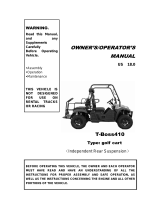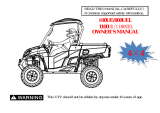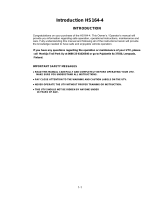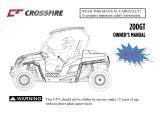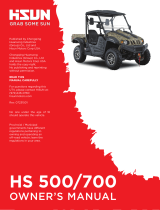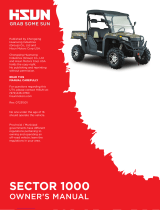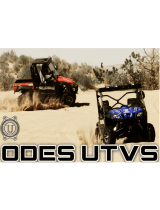Page is loading ...

MASSIMO ALLIGATOR 500 & MSU 500
Owner’s Manual

INTRODUCTION
Congratulations on your purchase of the Massimo Alligator 500 or MSU 500
UTV. With the purchase of this vehicle, you can now appreciate the high degree
of craftsmanship. This manual will provide you with a good basic understanding
of the features and operation of this vehicle. This manual includes important
safety information. It provides information about special techniques and skills nec-
essary to ride your vehicle. It also includes basic maintenance and inspection pro-
cedures. If you have any questions regarding the operation or maintenance of
your vehicle, please consult you dealer.
AN IMPORTANT SAFETY MESSAGE:
● READ THIS MANUAL FOR THE VEHICLE RIDER CAREFULLY AND COMPLETELY
BEFORE OPERATING YOUR VEHICLE. MAKE SURE YOU UNDERSTAND ALL
INSTRUCTIONS.
● PAY CLOSE ATTENTION TO THE WARNING AND CAUTION LABELS ON THE
VEHICLE.
● NEVER OPERATE A VEHICLE WITHOUT PROPER TRAINING OR INSTRUCTION.
FREE TRAINING IS AVAILABLE TO ANYONE WHO BUYS A NEW VEHICLE.
● THIS VEHICLE, AND ANY OTHER VEHICLE OVER 90cc, SHOULD NOT BE RIDDEN
BY ANYONE UNDER 16 YEARS OF AGE.


Owner Manual
IMPORTANT MANUAL INFORMATION
FAILURE TO FOLLOW THE WARNINGS CONTAINED IN THIS MANUAL CAN RESULT IN SERIOUS INJURY
OR DEATH. Particularly important information is distinguished in this manual by the following
notations:
The Safety Alert Symbol means ATTENTION!
YOUR SAFETY IS INVOLVED!
Failure to follow WARNING instructions could result in severe injury or death to
the machine operator, bystander or a person inspecting or repairing the
machine.
A CAUTION indicates special precautions that must be taken to avoid damage
to the machine.
A NOTE provides key information to make procedures easier or clearer.
NOTE:

Owner Manual
IMPORTANT NOTICE
This UTV is designed and manufactured for OFF - ROAD use only. It is illegal and unsafe to operate this
UTV on any public street, road or highway.
This UTV complies with all applicable OFF - ROAD noise level and spark arrester laws and regulations in
effect at the time of manufacture.
Please check your local riding laws and regulations before operating this UTV.
When the temperature is below -4°F (-20°C), park the UTV in a place where the temperature is higher
than -4°F (-20°C). Start the UTV after the UTV has warmed up. Please see page 6-3 on the warming up
process.
Follow the proper parking procedures when the temperature is higher than 100°F (38°C): turn off the
engine; make sure the radiator fan is on for 3 minutes before turning off the power switch.
Starting the UTV for the first time will take longer because the fuel will need reach the fuel injectors. To
start the UTV the first time, hold the ignition key on at 5-second intervals. Allow the starter to rest 15
seconds between each start attempt.

Owner Manual
Location of the Warning and
Specification Labels 1-1
Safety Information 2-1
Description and Vehicle
Identification 3-1
Identification Number Records 3-3
Vehicle Identification Number 3-3
Control Functions 4-1
Main Switch 4-1
Indicator and Warning Lights 4-2
Use of EPS system 4-4
Speedometer Unit 4-6
Odometer and Trip Meter Modes 4-6
Clock time adjustment 4-7
Fault code indicator 4-8
Fuel level indicator 4-9
Switches 4-9
Accelerator Pedal 4-14
Brake Pedal 4-15
Parking Brake Lever 4-15
Drive Select Lever 4-16
Fuel Tank Cap 4-17
Seats 4-17
Seat Belts 4-18
Glove Compartment 4-21
Cargo Bed 4-21
Opening and Closing the Tailgate 4-22
Lifting and Lowering the Cargo Bed
4-22
Front and Rear Shock Absorber
Adjustment 4-24
Trailer Hitch Bracket 4-26
Auxiliary DC Jack 4-27
Pre Operation Checks 5-1
Brakes 5-2
2
3
4
1
5

Owner Manual
Brake Fluid Level 5-2
Brake Fluid Leakage 5-3
Brake Operation 5-3
Fuel 5-4
Gasohol 5-4
Engine Oil 5-5
Coolant 5-6
Final Gear Oil 5-7
Differential Gear Oil 5-7
Throttle Pedal 5-8
Throttle Freeplay 5-9
Throttle Freeplay Inspection 5-9
Throttle Freeplay Adjustment 5-9
Steering Wheel Inspection 5-10
Seat Belts 5-10
Fittings and Fasteners 5-10
Lights 5-10
Switches 5-11
Tires 5-11
How to Measure Tire Pressure 5-12
Tire Wear Limit 5-13
Operation 6-1
Starting the Engine in Low
Temperatures 6-1
Starting the Engine 6-2
Warming Up 6-3
Drive Select Lever Operation and
Driving In Reverse 6-4
Parking 6-8
Parking on a Slope 6-8
Vehicle Break-in Period 6-9
Engine Break-In 6-10
Accessories 6-11
Loading 6-12
Driving Your Vehicle 7-1
Getting to Know Your Vehicle 7-1
6
7

Owner Manual
Learning to Operate Your Vehicle 7-5
Turning your Vehicle 7-6
Braking 7-8
Going Uphill 7-8
Going Downhill 7-10
Crossing Through Shallow Water 7-12
Riding Over Rough Terrain 7-15
Riding in Brush or Wooded Areas 7-17
Encountering Obstacles on the
Trail 7-17
Periodic Maintenance and
Adjustment 8-1
Periodic Maintenance Chart for the
Emission Control System 8-3
General Maintenance and
Lubrication Chart 8-4
Hood 8-7
Console 8-8
Engine Oil and Oil Filter Cartridge 8-9
To Check the Engine Oil Level 8-9
To Change the Engine Oil 8-10
Final Gear Oil 8-13
Changing the Final Gear Oil 8-15
Differential Gear Oil 8-16
Changing The Differential Gear Oil 8-17
Coolant 8-18
Axle Boots 8-19
Spark Plug Inspection 8-20
Inspection 8-21
Installation 8-21
Cleaning the Air Filter Elements 8-22
V-belt Cooling Duct Check Hose 8-26
V-belt Case Drain Plug 8-27
Cleaning the Spark Arrester 8-27
Valve Clearance 8-29
Front Brake Pad Check 8-29
Rear Brake Pad Check 8-30
Checking the Brake Fluid Level 8-31
8

Owner Manual
Brake Fluid Replacement 8-32
Checking the Brake Pedal 8-32
Parking Brake Lever Free Play
Adjustment 8-33
Brake Light Switch Adjustment 8-35
Cable Inspection and Lubrication 8-35
Brake Pedal and Accelerator Pedal
Lubrication 8-36
Rear Knuckle Upper and Lower
Pivot Lubrication 8-37
Steering Shaft Lubrication 8-37
Wheel Removal 8-37
Wheel Installation 8-38
Battery 8-39
Battery Maintenance 8-41
Fuse Replacement 8-41
Replacing Headlight Bulb 8-43
Headlight Beam Adjustment 8-46
Tail/brake Light Bulb Replacement 8-47
Troubleshooting 8-49
Solution to Common Problems in
the Vehicle 8-50
Cleaning and Storage 9-1
Cleaning 9-1
Storage 9-3
Specifications 10-1
Faultcode of Electronic Injection
System 11-1
USA EPA Emissions Limited
Warranty
12-1
12
9
10
11

Location of the Warning and Safety Labels 1-1
`
⑭
⑬

1-2 Location of the Warning and Safety Labels
Read and understand all of the labels on your vehicle. They contain important information for safe
and proper operation of your vehicle.
Never remove any labels from your vehicle. If a label becomes difficult to read or comes off, a
replacement label is available by contacting your dealer.
2

Location of the Warning and Safety Labels 1-3

1-4 Location of the Warning and Safety Labels

Location of the Warning and Safety Labels 1-5

1-6 Location of the Warning and Safety Labels
9
10

Location of the Warning and Safety Labels 1-7
11
14
12
13

2-1 Safety Information
This off-highway utility vehicle handles differently from other vehicles including cars and UTVs.
SEVERE INJURY OR DEATH can result if you do not follow these instructions:
● Read this manual and all labels carefully and follow the operating procedures described.
● This vehicle is designed to carry the driver and one passenger. NEVER CARRY PASSENGERS IN
THE CARGO BED.
● Always be sure the driver and passenger are wearing seat belts.
● Never give a ride to a passenger who is too small to reach and hold the handgrip fixed before the
seat.
● Always avoid operating the vehicle on any paved surfaces, including sidewalks, driveways, parking
lots, and streets.
● Never operate this vehicle on any public street, road, or highway, even dirt or gravel streets.
● Never operate this vehicle without wearing an approved motorcycle helmet that fits properly. You
should also wear eye protection (goggles or a face shield), gloves, over-the-ankle boots, long-sleeved
shirt or jacket, and long pants.
● Never consume alcohol or drugs before or while operating this vehicle.
● Never operate at speeds too fast for your skills or the conditions. Always go at a speed that is proper
for the terrain, visibility, operating conditions, and your experience.
SAFETY INFORMATION

Safety Information 2-2
● Never attempt jumps or other stunts.
● Always inspect your vehicle each time you use it to be sure it is in safe operating condition, Always
follow the inspection and maintenance procedures and schedules described in this manual.
● Always keep hands, arms, feet, and legs inside the vehicle at all times during operation. Keep your
feet on the floorboard. Never hold onto the enclosure. Your hand could be injured if it is caught
between the enclosure and an obstacle outside the vehicle.
● Always keep both hands on the steering wheel when driving.
● Never wrap your thumbs and fingers around the steering wheel. This is particularly important when
driving in rough terrain. The front wheels will move right and left as they respond to the terrain, and
this movement will be felt in the steering wheel. A sudden jolt could wrench the steering wheel around,
and your thumbs or fingers could be injured if they are in the way of the steering wheel spokes.
● Always go slowly and be extra careful when operating on unfamiliar terrain. Always be alert to
changing terrain conditions when driving the vehicle.
● Never operate on excessively rough, slippery, or loose terrain until you have learned and practiced
the skills necessary to control the vehicle on such terrain. Always be especially cautious on these
kinds of terrain.
● Never turn at excessive speed. Practice turning at slow speeds before attempting to turn at faster
speeds. Do not attempt turns on steep inclines.
● Never operate the vehicle on hills that are too steep for it or for your abilities. Go straight up and down
hills where possible. Maximum slope angle: 15°.

2-3 Safety Information
● Never operate on hills that are slippery or ones where you will not be able to see far enough ahead of
you. Never go over the top of a hill at speed if you cannot see what is on other side.
● Always follow proper procedures for going uphill. If you lose control and cannot continue up a hill,
back down the hill with the engine in reverse gear. Use engine braking to help you go slowly. If
necessary, use the brakes gradually to help you go slowly.
● Always check terrain before going down hills. Go as slowly as possible. Never go down a hill at high
speed.
● Always check for obstacles before operating in a new area.
● Never operate the vehicle in fast flowing water or water deeper than the floorboards on this model.
Remember that wet brakes may have reduced stopping ability. Test your brakes after leaving water. If
necessary, apply the brake several times to let friction dry out the linings.
● Always be sure there are no obstacles or people behind you when you operate in reverse. When it is
safe to proceed in reverse, go slowly.
● Do not brake abruptly when carrying loads in the cargo bed.
● Always use the size and type of tires specified in this manual.
● Always make sure the tires have the proper tire pressure as described in this manual.
● Never exceed the stated load capacity. Cargo should be as far forward in the bed as possible, and
distributed evenly from side to side. Be sure cargo is secured so that it cannot move around during
operation. Reduce speed and follow instructions in this manual for carrying cargo or pulling a trailer.
Allow greater distance for braking.

Safety Information 2-4
WARNING
POTENTIAL HAZARD
Improper handling of gasoline.
WHAT CAN HAPPEN
Gasoline can catch fire and you could be burned.
HOW TO AVOID THE HAZARD
Always turn off the engine when refueling. Do not refuel right after the engine has been running
and is still very hot. Do not spill gasoline on the engine or exhaust pipe(or muffler)when
refueling. Never refuel while smoking, or while in the vicinity of sparks, open flames, or other
sources of ignition such as the pilot light of water heaters and clothes dryers. When transporting
the vehicle in another vehicle, be sure it is kept in an upright position. Otherwise, fuel may leak
out of the engine or fuel tank.
WHAT CAN HAPPEN
Gasoline is poisonous and can cause injuries.
HOW TO AVOID THE HAZARD
If you should swallow some gasoline or inhale a lot of gasoline vapor, or get some gasoline in
your eyes, see your doctor immediately. If gasoline spills on your skin, wash with soap and
water. If gasoline spills on your clothing, change your clothes.
/


